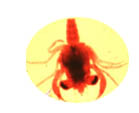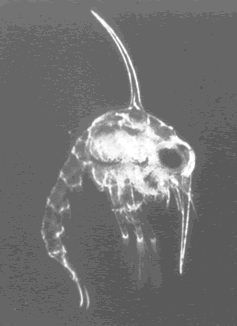 |
  |
 |
  |
|
|
Blue Crabs have what is called a Complex Life Cycle, meaning they have multiple stages throughout their lifetime, each with its own characteristics. A female with eggs, known as a sponge crab, migrates to the mouth of an estuary. Her eggs, which are carried under her apron, hatch larvae which are carried by currents out of the estuary and into the ocean.
After hatching, the tiny crabs spend about 30-45 days in their larval stage, known as zoea (see picture). At this stage, they have very little swimming capability, and as a result they go where the ocean currents take them. Their size at this stage is less than 1 mm. After 7-8 zoeal stages, they metamorphose into postlarvae, or megalopae, ranging in size from 1-3 mm. Megalopae are able to detect changes in salinity, light, and turbulence, and they use these cues to trigger vertical swimming behavior, which allows dark flood tides to carry them into estuaries. Once there, they settle in seagrass or shallow detrital habitats. Shortly after settling, they then metamorphose into juveniles.   Zoea (left) and Megalopae (right) stages of Blue Crab Juveniles molt, or shed their outer hard shell, numerous times and grow into adults. Adults also must molt in order to grow. A blue crab that has molted, but whose outer shell has not yet hardened, is known as a soft shelled crab. Adult females can mate only once in their life, when they molt from an immature to a mature female. After releasing their eggs, mature females return to the estuary where they die.
|